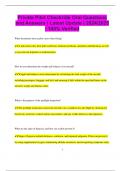Private Pilot Checkride Oral Questions
and Answers | Latest Update | 2024/2025
| 100% Verified
What documents must a pilot carry when flying?
✔✔A pilot must carry their pilot certificate, medical certificate, and photo identification, as well
as any relevant logbooks or endorsements.
How do you determine the weight and balance of an aircraft?
✔✔Weight and balance can be determined by calculating the total weight of the aircraft,
including passengers, baggage, and fuel, and ensuring it falls within the specified limits on the
aircraft's weight and balance chart.
What is the purpose of the preflight inspection?
✔✔The preflight inspection ensures the aircraft is in a condition for safe flight by checking for
fuel levels, oil levels, control surface movements, and any visible defects or discrepancies.
What are the signs of hypoxia, and how can a pilot prevent it?
✔✔Signs of hypoxia include dizziness, confusion, and impaired judgment. Pilots can prevent it
by using supplemental oxygen, maintaining altitude awareness, and recognizing symptoms early.
1
,Describe the importance of the traffic pattern.
✔✔The traffic pattern is crucial for organizing aircraft movement around an airport, ensuring
safe spacing and predictable flight paths for takeoffs and landings.
What should you do if you encounter engine failure during flight?
✔✔If engine failure occurs, pilots should maintain control of the aircraft, establish the best glide
speed, and identify a suitable landing area while troubleshooting the issue.
What is the purpose of a VOR and how does it work?
✔✔A VOR (VHF Omnidirectional Range) is a navigational aid that provides pilots with azimuth
information. It works by broadcasting a signal that allows pilots to determine their bearing from
the station.
What are the required altimeter settings for IFR flights?
✔✔Pilots must set the altimeter to the local altimeter setting upon departure and when
transitioning to the approach phase of the flight to ensure accurate altitude readings.
Explain how to handle a go-around procedure.
2
,✔✔In a go-around, pilots should apply full power, maintain a positive rate of climb, and retract
the landing gear and flaps as required while ensuring proper communication with ATC.
What is the significance of the "C" in "CAVU"?
✔✔The "C" in "CAVU" stands for "Ceiling," indicating that visibility is good, and the sky is
clear, which is ideal for flying conditions.
Describe the function of the pitot-static system.
✔✔The pitot-static system measures airspeed, altitude, and vertical speed by utilizing pressure
differences between static air and the airflow around the pitot tube.
What actions should be taken during an in-flight emergency?
✔✔During an in-flight emergency, pilots should assess the situation, prioritize actions,
communicate with ATC, and execute emergency procedures as needed to ensure safety.
How does weather affect flight operations?
✔✔Weather can significantly impact flight operations through visibility restrictions, turbulence,
icing conditions, and wind shear, which pilots must consider in their flight planning.
3
, What are the requirements for obtaining a private pilot certificate?
✔✔Requirements include a minimum of 40 flight hours, including 20 hours of flight training
with an instructor, passing a written exam, and successfully completing a practical test.
What is the function of the throttle in an aircraft?
✔✔The throttle controls the amount of fuel and air mixture entering the engine, directly
affecting engine power and aircraft speed.
Explain the significance of the “clearance delivery” communication before a flight.
✔✔Clearance delivery provides pilots with their initial flight clearance, including the route,
departure frequency, and transponder code needed for the flight.
What are the effects of altitude on engine performance?
✔✔As altitude increases, engine performance typically decreases due to lower air density, which
can affect power output and climb rate.
How do you identify the types of airspace in the U.S.?
✔✔U.S. airspace is classified into classes A, B, C, D, E, and G, each with specific regulations
regarding pilot qualifications and visibility requirements.
4




